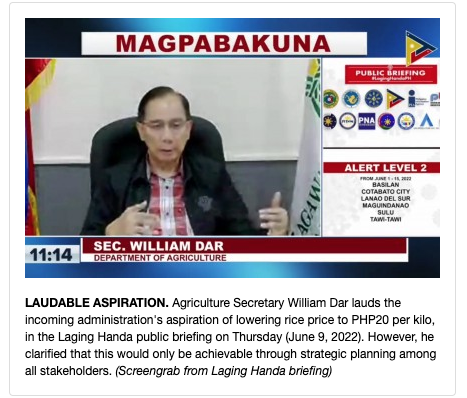
MANILA – Higher funding and increasing rice buffer stock will play a significant role in lowering the price of the staple in the country, the Department of Agriculture (DA) said Thursday.
Agriculture Secretary William Dar said a PHP20 per kilogram price of rice would be only feasible with strategic planning and programs “involving all sectors”.
“We have to really make it possible. Every efficiency that we can have; every good technology that we have; every opportunity to capacitate the farmers and engage the youth; we should have an increasing investment for post-harvest facilities including drying, milling, warehousing, we should invest,” he said in the Laging Handa briefing.
Dar, however, commended the aspiration of the next administration under President-elect Ferdinand “Bongbong” Marcos Jr., saying he shares the same “laudable” goal.
He said higher yields with lower production costs must be first achieved.
These prerequisites remain a challenge considering the continued conflict between Ukraine and Russia.
“Our latest analysis shows that if this war in Ukraine continues, the cost of production is at three pesos and thirty centavos. So add it to the present level, of course, producing a kilo of palay (unhusked rice) is at PHP11.50, so almost PHP14.80, the cost producing a kilo of palay is at fifteen pesos,” he said in mixed English and Filipino.
He also noted that it is important to identify “challenges and value chain approaches”.
“As I’ve said, we will increase productivity, yield targets, we will work on lowering the cost of production, which is currently increasing, we hope this will drop. So, we have many challenges that we have to put into consideration in this new program, designing this program towards the P20.00 rice price,” he said.
Dar said the incoming administration may opt to invest in increasing the buffer stock of the National Food Authority (NFA), setting China and India as examples with a 365-day buffer stock of rice.
“Strengthen the NFA; increase buffer stocking; increase the fund, as well as the fund for capital expenditure for us to do this. So, if we start this July towards the end of the year, they can have that capacity of good for 15 days but we see to it that if we have a stimulus bill, the capital expenditure should be increased so that next year they can go to full capacity of 30-day buffer stocking,” he said.
To date, only a PHP7 billion budget is being allocated for the NFA annually, which can only provide 300,000 metric tons of buffer stock only good for a week. (PNA)













